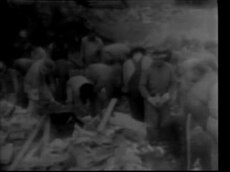New London School explosion
|
1937 newsreel
|
|
| Time | 3:05 – 3:20 p.m. Central Time |
|---|---|
| Date | March 18, 1937 |
| Location | New London, Texas |
| Deaths | 295+ |
| Non-fatal injuries | 300+ |
The New London School explosion occurred on March 18, 1937, when a natural gas leak caused an explosion, destroying the London School of New London, Texas, a community in Rusk County previously known as "London". The disaster killed more than 295 students and teachers, making it the deadliest school disaster in American history. As of 2014[update], the event is the third deadliest disaster in the history of Texas, after the 1900 Galveston hurricane, and the 1947 Texas City disaster.
In the mid-1930s, the Great Depression was in full swing, but the London school district was one of the richest in America. A 1930 oil find in Rusk County had boosted the local economy and educational spending grew with it. The London School, a large structure of steel and concrete, was constructed in 1932 at a cost of $1 million (roughly $17.6 million today). The London Wildcats (a play on the term "wildcatter", for an oil prospector) played football in the first stadium in the state to have electric lights.
The school was built on sloping ground and a large air space was enclosed beneath the structure. The school board had overridden the original architect's plans for a boiler and steam distribution system, instead opting to install 72 gas heaters throughout the building.
Early in 1937, the school board canceled their natural gas contract and had plumbers install a tap into Parade Gasoline Company's residue gas line to save money. This practice—while not explicitly authorized by local oil companies—was widespread in the area. The natural gas extracted with the oil was considered a waste product and was flared off. As there was no value to the natural gas, the oil companies turned a blind eye. This "raw" or "wet" gas varied in quality from day to day, even from hour to hour.
Untreated natural gas is both odorless and colorless, so leaks are difficult to detect and may go unnoticed. Gas had been leaking from the residue line tap and built up inside the enclosed crawlspace that ran the entire 253-foot (77 m) length of the building's facade. Students had been complaining of headaches for some time, but little attention had been paid to the issue.
...
Wikipedia

